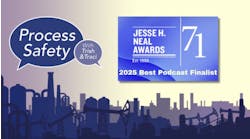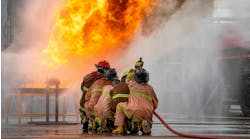As Editor Mark Rosenzweig pointed out in his editor’s column “What You Don’t Have Can’t Leak,” this issue’s cover story, “Take the Right Steps with Hazard Assessments,” aims to promote process safety. Its author, Trish Kerin, director of the IChemE Safety Centre, does far more for CP, however. She is a major contributor to our online offerings.
Indeed, many of you know her from the podcast series she and I host called “Process Safety With Trish & Traci.” We just wrapped episode 36, which focused on hydrogen safety.
Kerin also serves as our subject matter expert for all things process safety in our webinar series. This month’s webinar, “Take Steps to Reduce the Operational Risk Gap,” points out that people usually do things slightly differently than laid out in procedures and we then use that to explain why things go wrong. This is a mistake, warns Kerin. She will discuss how to best manage operations risk, including three types of adjustments to compensate for procedures not being done exactly the same way each time. She will also delve into managing the gap via inspection activities, lead metrics, audits and reviews. You can register for this webinar, or any others in our process safety series past or present, here.
And here’s a sneak peek into future webinar topics from Kerin:
After an incident has occurred, all the weak signals that were missed along the way or misinterpreted at the time usually seem all too obvious. This event will show how facilities can focus on seeing these signals and identifying them correctly so they can manage them properly.
Next year, Kerin will also explore building a learning organization. She notes that Trevor Kletz once said, “Organizations have no memory, only people have memory, and they move on.” The challenge becomes embedding learning so people and the organization can benefit in the future.
According to one of our quick poll questions, our readers do well sharing incident insights. We asked: How would you characterize your company’s effectiveness in sharing safety learnings among its various sites? More than two-thirds (69.5%) of respondents noted Good (40.6%) or Excellent (28.9%). But there is always room for improvement. And as Kerin often states, if her presentations help save one life, it’s worth doing them.
Another poll asked how adequate is the attention your site gives to combustible dust control? Less than one-third felt their attention was very adequate (31.6%) and nearly one-quarter (21.2%) of the respondents stated the attention was slightly adequate (15.9%) or not at all (5.3%). You can access all past poll results here.
So, CP runs an ongoing series of webinars on this important topic. The next, on Nov. 2, will feature a roundtable discussion about combustible dust, which can pose significant hazards to personnel, plant equipment, and even the surrounding community. In this event, Guy Colonna, former director of engineering for the National Fire Protection Association and currently principal engineer with FSL Consulting LLC, will moderate a panel discussion with industry experts on dealing with these hazards. The panel will offer insights on key challenges and provide practical guidance on how to identify, evaluate and effectively address hazards.
If you’re wondering why the final quarter of the year is dedicated to safety, we try to coincide with an event that honors the loss of life in an explosion at the Phillips Petroleum Complex in Pasadena, Texas. It was on that day, Oct. 23, 1989, Mary Kay O’Connor, an operations superintendent, died in the explosion.
While safety incidents occur every day of the year, this event spurred the creation of the Mary Kay O’Connor Process Safety Center (MKOPSC) at Texas A&M University. Just recently, MKOPSC’s founder, Michael O’Connor (Mary Kay’s husband), passed away (you can read my tribute to him here: “Chemical Safety Leader, Loving Husband Passes").
In honor of the O’Connors, Trevor Kletz and the continued work of Trish Kerin and Guy Colonna, here’s to a safe rest of 2022.



